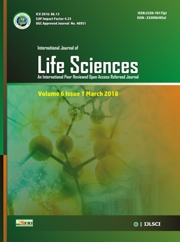RESEARCH ARTICLES
Volume 9 |Issue 2| March-April 2021 First published: 30 April 2021
Physico-chemical Properties of Sediments of Kondeshwar Lake, Badnera, District Amravati, Maharashtra, India
Deshmukh SV1 and Wharekar SR2
1Bar. RDIK and KD College Badnera, Amravati, MS, India
2Department of Environmental Science, Art, Commerce and Science College, Kiran Nager, Amravati, MS, India
*Corresponding author: Email: shrikant.warhekar@gmail.com
Abstract
Keywords:Dregs, catchment, lake sediments, available phosphorous/p>
Editor: Dr.Arvind Chavhan
Cite this article as:
Deshmukh SV and Wharekar SR. Physico-chemical Properties of Sediments of Kondeshwar Lake, Badnera, District Amravati, Maharashtra, India, Int. Res. Journal of Science & Engineering, 2021, Volume 9(2): 57-60.
References
1. United States Environmental Protection Agency (USEPA) (2002) Water Quality Monitoring for Coffee Creek (Porter County, Indiana). Retrieved from: http/www.usepa/research.htm.modecode=62- 28-00-00
2. Battarbee RW (1999) The importance of paleolimnology to lake restoration. Hydrobiologia, 395/396:149-159.
3. Matisoff G, Fisher JB and Matis S (1985) Effects of benthic macroinvertebrates on the exchange of solutes between sediments and freshwater. Hydrobiologia, 122:9-33
4. Sahoo JK, Khuntia B K and Sial NK (2007) Nutrient dynamics in the sediments of lagoonal environment of Bahuda estuary, Orissa. J. Aquat. Biol., 22(1) :39-44.
5. Issa BR, Arimoro FO, Ibrahim M, Birma GJ and E A Fadairo (2011) Assessment of sediment contamination by heavy metals in river Orogodo (Agbor, Delta state, Nigeria), Current World Environment,6 (1): 29- 38.
6. Pravin US, Manisha PT and M M Ravindra (2011) Assessing the Physico-Chemical Parameters of Sediment Ecosystem of Vasai Creek at Mumbai, India. Marine Science,1(1):22-29.doi: 10.5923/j.ms.20110101.03.
7. Hodson PV(1986) Water quality criteria and the need for biochemical monitoring of contaminant effects on aquatic ecosystem. In: Water Quality Management: Freshwater Eco-toxicity in Australia, Hart, B.T. (ed.), Melbourne Water Studies Center, pp:7-21.
8. Haslam SM (1990) River pollution: An ecological perspective, Belhaven Press. London, pp:253.
9. Sediment Management and Dredging in Lakes (2002) A report based on a workshop held at Arlington Court, Devon.
10. Trivedy RK and Goel PK (1986) Chemical and biological methods for water pollution studies. Environmental Publication, Karad.
11. Arun B and Mukharjee N (1998) A review of occurrences, uses, emissions, and concentration in the environment in Finland. Environ.Rev.6:1-5.
12. Kimberly MFH and William H (1999) Trace metals in Montreal urban soils and the leaves of Teraxacum officinale. Can.J.Soil Sci. 79:L385-387.
13. Sauve S, Henderson Wand Allen HE (2000) Solid solution portioning of metals in contaminated soils: dependence on pH, total metal burden and organic matter. Env. Sci. Techn. 34:1125-1131.
14. Rana L, Dhankhar R. and Chhikara S. (2010) Soil characteristics affected by long term application of sewage wastewater. Int. J. Environ. Res., 4(3): 513-518, Summer 2010
15. Henderson GS (1995) Soil organic matter: A link between forest management and productivity. In: W.H. McFee and J.M. Kelly, editors. Carbon forms and functions in forest soils. Madison, WI: Soil Science Society of America: 419-435
16. Soil and Plant Analysis Council (1999) Soil Analysis. Handbook of reference methods. Boca Raton, FL: CRC Press. 247 p.
17. Woods CW, Mitchell R J, Zutter BR and Lin CL (1992) Loblolly pine plant community effects on soil carbon and nitrogen. Soil Science 154, 410-419.
18. Amacher C, Michael KP, O’Neill and Perry CH (2007) Soil Vital Signs: A new soil quality index (SQI) for assessing forest soil health. Res. Pap. RMRS-RP-65WWW. FortCollins, CO: US Dept. of Agriculture, forest service, Rocky Mountain Research Station. Pp.12.

